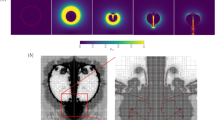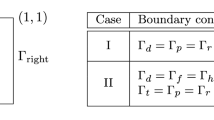Abstract
A meshfree approach to the simulation of the large deformation of a curved shell by the reproducing kernel particle method (RKPM) is presented. Since the kinematic description is based on the Mindlin–Reissner shell theory, only one layer of particles is needed to model the shell and the time increment is not limited by the shell thickness. The reproducing interpolation function is adopted to discretize the kinematic quantities of the shell; thus, the spatial discretization is independent of the finite element mesh, so it can address large deformations without mesh distortion. The governing equation of an arbitrary curved shell is derived in detail based on the principle of virtual power, for which reasonable simplifications have been taken. The Lagrangian kernel and stress points are adopted in the calculation, which are sufficient to eliminate instability. Several numerical examples are performed, verifying the reliability and numerical accuracy of the RKPM shell model. No locking is observed in the numerical solutions.














Similar content being viewed by others
References
Monaghan JJ (1994) Simulating free surface flows with SPH. J Comput Phys 110:399–406
Grenier N, Antuono M, Colagrossi A, Le Touzé D, Alessandrini B (2009) An Hamiltonian interface SPH formulation for multi-fluid and free surface flows. J Comput Phys 228:8380–8393
Rabczuk T, Belytschko T (2004) Cracking particles: a simplified meshfree method for arbitrary evolving cracks. Int J Numer Methods Eng 61:2316–2343
Rabczuk T, Areias P, Belytschko T (2007) A meshfree thin shell method for nonclinear dynamic fracture. Int J Numer Methods Eng 72:524–548
Ren B, Li S (2012) Modeling and simulation of large-scale ductile fracture in plates and shells. Int J Solids Struct 49:2373–2393
Rabczuk T, Gracie R, Song J-H, Belytschko T (2010) Immersed particle method for fluid–structure interaction. Int J Numer Methods Eng 22:48
Potapov S, Maurel B, Combescure A, Fabis J (2009) Modeling accidental-type fluid–structure interaction problems with the SPH method. Comput Struct 87:721–734
Ming FR, Zhang AM, Xue YZ, Wang SP (2016) Damage characteristics of ship structures subjected to shockwaves of underwater contact explosions. Ocean Eng 117:359–382
Gingold RA, Monaghan JJ (1977) Smoothed particle hydrodynamics: theory and application to non-spherical stars. Mon Not R Astron Soc 181:375–389
Lucy LB (1977) A numerical approach to the testing of the fission hypothesis. Astron J 82:1013–1024
Belytschko T, Lu YY, Gu L (1994) Elementcfree Galerkin methods. Int J Numer Methods Eng 37:229–256
Liu WK, Jun S, Zhang YF (1995) Reproducing kernel particle methods. Int J Numer Methods Fluids 20:1081–1106
Dilts GA (1999) Movingc-least-squares-particle hydrodynamics—I. Consistency and stability. Int J Numer Methods Eng 44:1115–1155
Belytschko T, Lu Y, Gu L, Tabbara M (1995) Element-free Galerkin methods for static and dynamic fracture. Int J Solids Struct 32:2547–2570
Belytschko T, Organ D, Gerlach C (2000) Element-free Galerkin methods for dynamic fracture in concrete. Comput Methods Appl Mech Eng 187:385–399
Li S, Simonsen CB (2005) Meshfree simulations of ductile crack propagations. Int J Comput Methods Eng Sci Mech 6:1–19
Li S, Hao W, Liu WK (2000) Mesh-free simulations of shear banding in large deformation. Int J Solids Struct 37:7185–7206
Jun S, Liu WK, Belytschko T (1998) Explicit reproducing kernel particle methods for large deformation problems. Int J Numer Methods Eng 41:137–166
Belytschko T, Guo Y, Liu WK, Xiao SP (2000) A unified stability analysis of meshless particle methods. Int J Numer Methods Eng 48:1359–1400
Swegle J, Hicks D, Attaway S (1995) Smoothed particle hydrodynamics stability analysis. J Comput Phys 116:123–134
Chen J-S, Pan C, Wu C-T, Liu WK (1996) Reproducing kernel particle methods for large deformation analysis of non-linear structures. Comput Methods Appl Mech Eng 139:195–227
Randles P, Libersky L (1996) Smoothed particle hydrodynamics: some recent improvements and applications. Comput Methods Appl Mech Eng 139:375–408
Krysl P, Belytschko T (1996) Analysis of thin shells by the element-free Galerkin method. Int J Solids Struct 33:3057–3080
Donning BM, Liu WK (1998) Meshless methods for shear-deformable beams and plates. Comput Methods Appl Mech Eng 152:47–71
Chen JS, Wang D (2006) A constrained reproducing kernel particle formulation for shear deformable shell in Cartesian coordinates. Int J Numer Methods Eng 68:151–172
Maurel B, Combescure A (2008) An SPH shell formulation for plasticity and fracture analysis in explicit dynamics. Int J Numer Methods Eng 76:949–971
Zhang A, Ming F, Cao X (2014) Total Lagrangian particle method for the large-deformation analyses of solids and curved shells. Acta Mech 225:253–275
Lin J, Naceur H, Coutellier D, Laksimi A (2014) Geometrically nonlinear analysis of thin-walled structures using efficient Shell-based SPH method. Comput Mater Sci 85:127–133
Caleyron F, Combescure A, Faucher V, Potapov S (2012) Dynamic simulation of damage–fracture transition in smoothed particles hydrodynamics shells. Int J Numer Methods Eng 90:707–738
Günther FC, Liu WK (1998) Implementation of boundary conditions for meshless methods. Comput Methods Appl Mech Eng 163:205–230
Li S, Hao W, Liu WK (2000) Numerical simulations of large deformation of thin shell structures using meshfree methods. Comput Mech 25:102–116
Hughes TJ, Liu WK (1981) Nonlinear finite element analysis of shells: part I. Three-dimensional shells. Comput Methods Appl Mech Eng 26:331–362
Monaghan JJ (2005) Smoothed particle hydrodynamics. Rep Prog Phys 68:1703
Monaghan JJ, Lattanzio JC (1985) A refined particle method for astrophysical problems. Astron Astrophys 149:135–143
Benson D, Bazilevs Y, Hsu M-C, Hughes T (2010) Isogeometric shell analysis: the Reissner–Mindlin shell. Comput Methods Appl Mech Eng 199:276–289
Hughes TJR (1987) The finite element method: linear static and dynamic finite element analysis. Prentice-Hall, Englewood Cliffs
Belytschko T, Liu WK, Moran B, Elkhodary K (2013) Nonlinear finite elements for continua and structures. Wiley, New York
Gosz J, Liu WK (1996) Admissible approximations for essential boundary conditions in the reproducing kernel particle method. Comput Mech 19:120–135
Betsch P, Menzel A, Stein E (1998) On the parametrization of finite rotations in computational mechanics: a classification of concepts with application to smooth shells. Comput Methods Appl Mech Eng 155:273–305
Owen DR, Hinton E (1980) Finite elements in plasticity: theory and practice. UK, Pineridge Press
Swaddiwudhipong S, Liu Z (1996) Dynamic response of large strain elasto-plastic plate and shell structures. Thin-Walled Struct 26:223–239
Belytschko T, Stolarski H, Liu WK, Carpenter N, Ong JS (1985) Stress projection for membrane and shear locking in shell finite elements. Comput Methods Appl Mech Eng 51:221–258
Simo J, Fox D, Rifai M (1989) On a stress resultant geometrically exact shell model. Part II: the linear theory; computational aspects. Comput Methods Appl Mech Eng 73:53–92
Ibrahimbegović A (1995) On finite element implementation of geometrically nonlinear Reissner’s beam theory: three-dimensional curved beam elements. Comput Methods Appl Mech Eng 122:11–26
Acknowledgements
The authors appreciate the help of Prof. Shaofan Li from University of California Berkeley for his guidance and instructions. And the authors thank the State Key Program of National Natural Science of China (U1430236) for their support.
Author information
Authors and Affiliations
Corresponding author
Rights and permissions
About this article
Cite this article
Peng, Y.X., Zhang, A.M. & Ming, F.R. A thick shell model based on reproducing kernel particle method and its application in geometrically nonlinear analysis. Comput Mech 62, 309–321 (2018). https://doi.org/10.1007/s00466-017-1498-9
Received:
Accepted:
Published:
Issue Date:
DOI: https://doi.org/10.1007/s00466-017-1498-9




